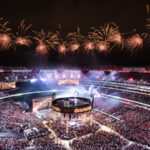You don’t have to be that old to be surprised with the fact that George Michael, frontman for the 1980s pop band Wham!, has been performing for more than a quarter of a century. The first leg of his 25 Live tour, which supports a greatest hits album by the same name, traveled though Europe in late 2006. The North American leg that began earlier this year represents the artist’s first live tour in the U.S. and Canada in 17 years. Benoit “Ben” Richard, lighting designer and director, and Richard Shipman, video programmer/director/department head, say Michael played a significant role in coming up with the ideas for the tour’s visuals, where video dominates and lighting plays a supporting role.
“I’m sad that the tour is almost over,” Richard said. “All great things must come to an end. But I’m ready for the next big challenge.” In little more than a blink of an eye, that might just be a George Michael tour called 50 Live.
Video Steals the Show
Benoit “Ben” Richard: “Late in 2005, Vince Foster was the original lighting and set designer for the show but when he had to leave for another tour, I was brought in to take over after the first dozen shows in Europe in Oct. 2006. Willie Williams and Ken Watts worked with Barco to develop the MiStrips for this highly visual show. George Michael himself actively participated in all aspects of the design process and everything you see during the show comes from his original ideas. There’s no doubt that the video screens are the main highlight of the show. The lighting system serves as a ‘supporting role’ to pump the beat in the dance numbers and make the slower songs more theatrical. We also programmed the show to time code, which makes the whole experience even more impressive.”
Support from the Crew
Benoit “Ben” Richard: “To my right at front of house is Blake Rogers, who has been my right hand man forever. On this tour, I needed him to be at front of house during the show to monitor the system and to deal with me moaning about broken gear. Thanks to his hard work and dedication to the project, we’ve had great shows during this North American leg. Kevin Forster, the account rep at Ed & Ted’s Excellent Lighting put together a great crew for us on this tour. Richard Shipman started at front of house and used Zookeeper to commu-nicate with his three Green Hippo Hippotizer media servers backstage. Once everything was programmed and locked to code, he moved backstage and monitored the show from a Spy-Cam feed at the front of house.”
A Political Juggling Act
Richard Shipman: “I joined the U.S. leg in May for pre-production to iron out some previous issues. I’m the department head for video and the graphics programmer/editor and final vi-sion mixer for all screen content. I liaised with the software suppliers on formats, pixel ratios and general formatting of any content for the screens. During the show I vision mix between the graphics and the camera cut, inserting camera pictures with the visuals as agreed with George directly. I’m responsible for all aspects of the visual look of the show and act as a bridge between tour production, artist production and software producers, so you could say I am a ‘politician.’ I am the bridge for tour artist and content providers to ensure the screen hardware is built and working, that the material is synched and correct with cameras inserted to George’s brief, and that the current or revised edits of any content are being used and managed for the software providers or content production. Before the tour in pre-production, I specified the graphics units from XL Video, liaised with the content providers, Bikini Films, and received an artist brief from George regarding final overall looks for the tour. It was quite a juggling act.”
Serving Up the Video Content
Richard Shipman: “I’m using Hippotizer V3 units running from MIDI time code triggering three independent timelines, one for each screen, managed by a Zookeeper PC at front of house via a Cat 6 Ethernet link to the servers backstage. The PPU camera cut by Paul Eggerton is fed into the Hippos live and any DVE sizing and mirror effects are via the Hippos, thus eliminating delay down to two frames to the screen. This final vision mix is done uniquely via a MIDI map on the Zookeeper system onto a Berringer BCF2000 unit. So all I had at front of house was a laptop PC and the BCF. Nigel Saddler at Green Hippo, who wrote some specific code required for this MIDI map and timecode display, was a big help.”
